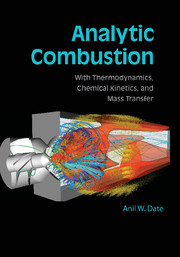Book contents
- Frontmatter
- Contents
- Preface
- Symbols and Acronyms
- 1 Introduction
- 2 Thermodynamics of a Pure Substance
- 3 Thermodynamics of Gaseous Mixtures
- 4 Chemical Equilibrium
- 5 Chemical Kinetics
- 6 Derivation of Transport Equations
- 7 Thermochemical Reactors
- 8 Premixed Flames
- 9 Diffusion Flames
- 10 Combustion of Particles and Droplets
- 11 Combustion Applications
- APPENDIX A Thermochemistry Data
- APPENDIX B Curve-Fit Coefficients for Δhc, Tad, Kp, Cp, h, and s
- APPENDIX C Properties of Fuels
- APPENDIX D Thermophysical and Transport Properties of Gases
- APPENDIX E Atmospheric Data
- APPENDIX F Binary Diffusion Coefficients at 1 atm and T = 300K
- Bibliography
- Index
2 - Thermodynamics of a Pure Substance
- Frontmatter
- Contents
- Preface
- Symbols and Acronyms
- 1 Introduction
- 2 Thermodynamics of a Pure Substance
- 3 Thermodynamics of Gaseous Mixtures
- 4 Chemical Equilibrium
- 5 Chemical Kinetics
- 6 Derivation of Transport Equations
- 7 Thermochemical Reactors
- 8 Premixed Flames
- 9 Diffusion Flames
- 10 Combustion of Particles and Droplets
- 11 Combustion Applications
- APPENDIX A Thermochemistry Data
- APPENDIX B Curve-Fit Coefficients for Δhc, Tad, Kp, Cp, h, and s
- APPENDIX C Properties of Fuels
- APPENDIX D Thermophysical and Transport Properties of Gases
- APPENDIX E Atmospheric Data
- APPENDIX F Binary Diffusion Coefficients at 1 atm and T = 300K
- Bibliography
- Index
Summary
Introduction
The main purpose of this chapter is to briefly recapitulate what is learned in a first course in classical thermodynamics. As defined in Chapter 1, thermodynamics is the science of relationships among heat, work and the properties of the system. Our first task, therefore, will be to define the keywords in this definition: system, heat, work, and properties. The relationships among these quantities are embodied in the first and the second laws of thermodynamics. The laws enable one to evaluate change in the states of the system, as identified by the changes in its properties. In thermodynamics, this change is called a process, although, in common everyday language, the processes may be identified with terms such as cooling, heating, expansion, compression, phase-change (melting, solidification, evaporation, condensation), or chemical reaction (such as combustion or catalysis). As such, it is important to define two additional terms: state and process.
The last point is of particular importance, because the statements of thermodynamic problems are often couched in everyday language. However, with the help of the definitions given in the next section, it will become possible not only to to deal with all processes in a generalized way but also to recognize whether a given process can be dealt with by thermodynamics. Thus, adherence to definitions is very important in thermodynamics. Establishing a connection between the problem statement in everyday language and its mathematical representation is best helped by drawing a sketch by hand.
- Type
- Chapter
- Information
- Analytic CombustionWith Thermodynamics, Chemical Kinetics and Mass Transfer, pp. 12 - 47Publisher: Cambridge University PressPrint publication year: 2011



